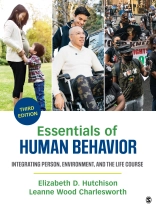Essentials of Human Behavior combines Elizabeth D. Hutchison’s two best-selling
Dimensions of Human Behavior volumes into a single streamlined volume for understanding human behavior. The text presents a multidimensional framework integrating person, environment, and time to show students the dynamic, changing nature of person-in-environment. In this
Third Edition, Hutchison is joined by new co-author Leanne Wood Charlesworth, who uses her practice and teaching experience to help organize the book’s cutting-edge research and bring it into the classroom. The text will thoroughly support students′ understanding of human behavior theories and research and their applications to social work engagement, assessment, intervention, and evaluation across all levels of practice.
This title is accompanied by a complete teaching and learning package.
Cuprins
Case Studies
Preface
Note from the Editors
Acknowledgments
About the Editors
About the Contributors
Part I . A Multidimensional, Multitheoretical Approach for Multifaceted Social Work
Chapter 1 . Human Behavior: A Multidimensional Approach
Human Behavior: Individual and Collective
A Multidimensional Approach
Diversity, Inequality, and the Pursuit of Social Justice: A Global Perspective
Knowing and Doing
Scientific Knowledge: Theory and Research
Organization of the Book
Implications for Social Work Practice
Key Terms
Active Learning
Web Resources
Chapter 2 . Theoretical Perspectives on Human Behavior
Multiple Perspectives for a Multidimensional Approach
Systems Perspective
Conflict Perspective
Exchange and Choice Perspective
Social Constructionist Perspective
Psychodynamic Perspective
Developmental Perspective
Behavioral Perspective
Humanistic Perspective
The Merits of Multiple Perspectives
Implications for Social Work Practice
Key Terms
Active Learning
Web Resources
Part II . The Multiple Dimensions of the Person
Chapter 3 . The Biological Person
An Integrative Approach for Understanding the Intersection of Interior Biological Health and Illness and Exterior Environmental Factors
Systems Taxonomy: Six Interior Environment Systems
Ecobiodevelopmental Framework to Understand the Relationship Between Interior Health and Exterior Environments
Implications for Social Work Practice
Key Terms
Active Learning
Web Resources
Chapter 4 . The Psychological Person
Cognition and Emotion
Theories of Cognition
Theories of Emotion
The Self
The Self in Relationships
The Concept of Stress
Coping and Adaptation
Normal and Abnormal Coping
Implications for Social Work Practice
Key Terms
Active Learning
Web Resources
Chapter 5 . The Spiritual Person
The Spiritual Dimension
Theories of Spiritual Development
The Role of Spirituality in Social Work
Implications for Social Work Practice
Key Terms
Active Learning
Web Resources
Part III . The Multiple Dimensions of the Environment
Chapter 6 . Cultures and the Physical Environment
Physical Environment
What Is Culture?
Theories of Culture
Major Concepts in the Study of Culture
Culture and Power
Genes and Culture
How Culture Changes
The Relationship Between the Physical Environment and Human Behavior
The Natural Environment
The Built Environment
Accessible Environments for Persons With Disabilities
Implications for Social Work Practice
Key Terms
Active Learning
Web Resources
Chapter 7 . Families
Family Defined
The Family in Historical Perspective
Theoretical Perspectives for Understanding Families
Diversity in Family Life
Challenges to Family Life
Implications for Social Work Practice
Key Terms
Active Learning
Web Resources
Chapter 8 . Small Groups, Formal Organizations, and Communities
Small Groups in Social Work
Small Group Structure, Composition, and Processes
Theories of Group Processes
Formal Organizations: Definition and Theoretical Perspectives
Community: Territorial and Relational
Theoretical Approaches to Community
Implications for Social Work Practice
Key Terms
Active Learning
Web Resources
Chapter 9 . Social Structure, Social Institutions, and Social Movements: Global and National
Patterns of Social Life
Contemporary Trends in Global and U.S. Social Institutions
Theories of Social Inequality
Social Movements: Definition and Theoretical Perspectives
Implications for Social Work Practice
Key Terms
Active Learning
Web Resources
Part IV . The Changing Life Course
Chapter 10 . The Human Life Journey: A Life Course Perspective
The Life Course Perspective
Theoretical Roots of the Life Course Perspective
Basic Concepts of the Life Course Perspective
Major Themes of the Life Course Perspective
Life Course Developmental Perspective on Families
The Life Course Perspective and Social Work Practice
Integration With a Multidimensional, Multitheoretical Approach
Implications for Social Work Practice
Key Terms
Active Learning
Web Resources
Chapter 11 . The Journey Begins: Conception, Pregnancy, Childbirth, and Infancy
Sociocultural Organization of Childbearing and Child-Rearing
Control Over Conception and Pregnancy
Fetal Development
At-Risk Newborns
Typical Infant Development
The Role of Play
Childcare Arrangements in Infancy
Infants in the Multigenerational Family
Risk and Protective Factors in Conception, Pregnancy, Childbirth, and Infancy
Implications for Social Work Practice
Key Terms
Active Learning
Web Resources
Chapter 12 . Toddlerhood and Early Childhood
Typical Development in Toddlerhood and Early Childhood
The Role of Play
Developmental Delays and Disabilities
Early Childhood Education
Toddlerhood and Early Childhood in the Multigenerational Family
Risks to Healthy Development in Toddlerhood and Early Childhood
Protective Factors in Toddlerhood and Early Childhood
Implications for Social Work Practice
Key Terms
Active Learning
Web Resources
Chapter 13 • Middle Childhood
Historical Perspective on Middle Childhood
Middle Childhood in the Multigenerational Family
Development in Middle Childhood
Middle Childhood and Formal Schooling
Special Challenges in Middle Childhood
Risk Factors and Protective Factors in Middle Childhood
Implications for Social Work Practice
Key Terms
Active Learning
Web Resources
Chapter 14 . Adolescence
The Social Construction of Adolescence Across Time and Space
The Transition From Childhood to Adulthood
Biological Aspects of Adolescence
Psychological Aspects of Adolescence
Social Aspects of Adolescence
Adolescent Spirituality/Religiosity
Adolescent Sexuality
Potential Challenges to Adolescent Development
Risk Factors and Protective Factors in Adolescence
Implications for Social Work Practice
Key Terms
Active Learning
Web Resources
Chapter 15 . Young and Middle Adulthood
The Meaning of Adulthood
Theoretical Approaches to Adulthood
Physical Functioning in Young and Middle Adulthood
Cognition in Young and Middle Adulthood
Personality and Identity in Young and Middle Adulthood
Young- and Middle-Adult Spirituality
Relationships in Young and Middle Adulthood
Work in Young and Middle Adulthood
Risk Factors and Protective Factors in Young and Middle Adulthood
Implications for Social Work Practice
Key Terms
Active Learning
Web Resources
Chapter 16 . Late Adulthood
Demographics of the Older-Adult Population
Cultural Construction of Late Adulthood
Psychosocial Theoretical Perspectives on Social Gerontology
Biological Changes in Late Adulthood
Psychological Changes in Late Adulthood
Social Role Transitions and Life Events of Late Adulthood
The Search for Personal Meaning
Resources for Meeting the Needs of Elderly Persons
The Dying Process
Loss, Grief, and Bereavement
Risk Factors and Protective Factors in Late Adulthood
The Life Course Completed
Implications for Social Work Practice
Key Terms
Active Learning
Web Resources
Glossary
References
Index
Despre autor
Leanne Wood, LMSW, Ph.D., received her M.S.W from the University at Albany and Ph D from Virginia Commonwealth University. Leanne is currently an Assistant Professor in the Department of Social Work at Nazareth College of Rochester, where she teaches a variety of courses including Human Behavior and the Social Environment. She has served in child protection and other capacities within child welfare systems and has been an evaluation consultant to diverse public and private human service agencies. Her research and practice interests focus on poverty, child and family well-being, and child welfare system issues.












